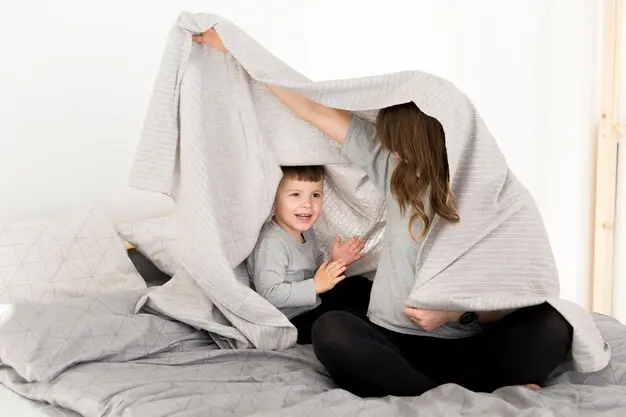Every parent is aware of the difficulty of bedding a restless child. Nothing seems to help you—warm milk, goodnight stories, every lullaby in the book. Here may be the answer you have been looking for—a weighted blanket. These specially made blankets offer mild pressure to assist in calming small bodies and brains.
Weighted blankets are packed with tiny beads or pellets that uniformly distribute weight over the body, unlike standard infant bed sheets or lightweight quilts. Many children find this to be a very consoling “hug.” As we will see, the advantages go much beyond simply keeping warm; these blankets can help your child’s nervous system be more regulated for better sleep.
What Makes Weighted Blankets Different?
Weighted blankets differ from standard bedding in several key respects. Although a basic quilt might weigh one to two pounds, weighted blankets are meticulously calibrated to offer five to 10% of the user’s body weight. This additional weight provides what occupational therapists describe as “deep pressure stimulation,” not only warmth.
This soft pressure has the same effect as swaddling calms for infants, and a hard hug can help soothe an agitated child. The weight of the blanket sets off melatonin and serotonin release, lowering cortisol, the stress hormone. Many parents claim their children fall asleep faster and stay longer when using a weighted blanket; this biological reaction helps explain why.
Furthermore, the building process is important. Unlike one hefty mass, quality weighted blankets spread their weight across tiny, evenly spaced pockets. This keeps that consoling embrace sensation throughout the night and helps avoid awkward pressure points.
The Science Behind Weighted Blankets and Sleep
Studies on weighted blanket efficacy offer encouraging findings, especially for kids with sensory processing issues. In a 2020 study published in the Journal of Sleep Medicine and Disorders, 78% of weighted blanket users said their anxiety levels at nighttime were reduced.
Children would especially benefit from this relaxing influence. Many children find it difficult to move from the hectic stimulus of daily to the stillness required for sleep. The pressure of the blanket signals their neurological system that it’s time to relax physically. See it as a mild “off switch” for their active brains.
The advantages go beyond merely nodding off by minimising the little awakenings that would cause complete wake-up; the same deep pressure stimulation aids in preserving sleep. Regularly wearing a weighted blanket helps parents find their children sleep more peacefully and wake up less frequently.
Choosing the Right Weighted Blanket for Your Child
Safety should always be the front stage when choosing a weighted blanket for your child. Generally speaking, you should select a blanket that is one pound heavier relative to your child’s weight —about 10% of it. That would translate for a 5-6 pound blanket for a 50-pound toddler.
Size counts as well. The blanket should cover your child’s body without hanging too much over the borders of their baby bed. Most producers provide child-sized versions of their blankets, which are smaller than adult ones and provide the appropriate coverage without extra material that can tangle.
One more crucial factor is material selection. Especially for smaller children, look for breathable materials like cotton to help reduce overheating. Usually glass beads or plastic poly pellets, the filler material should be well sealed in stitched pockets to stop leakage or shifting.

Safety Considerations Every Parent Should Know
Although weighted blankets have many advantages, every child will find them suitable in different ways. The NHS Borders Children’s Occupational Therapy Service advises caution for children with some disorders.
Young children under two years old should avoid weighted blankets because of suffocating concerns. See your paediatrician before use in older children experiencing limited mobility, respiratory problems, or temperature control difficulties.
Always watch first uses to make sure your child can remove the blanket on her own, should necessary. Look for uncomfortable symptoms such restlessness, sweating, or trouble breathing. The blanket should be reassuring rather than constrictive.
Children who find the typical weighted blanket too strong might look at alternatives including compression sheets that offer comparable deep pressure with less weight. Younger children changing from conventional baby bed sheets may find these especially helpful.
Real Parent Experiences with Weighted Blankets
Many parents say using a weighted blanket results in significant changes. Mother of a 7-year-old with ADHD, Sarah says: “My daughter fell asleep 30 minutes faster than usual first night we used the blanket. She was sleeping through the night for the first time in years a week later.”
Michael, another parent, observed changes in his worried five-year-old: “The blanket appears to offer him just enough pressure to feel secure without being confined. Actually, he requests it at night now and refers to it as his “hug blanket.”
Although outcomes differ, the commonality is that many kids react favourably to the light pressure. Though it’s not a miraculous fix, it can clearly improve nighttime difficulties when combined with other good sleep routines.

Incorporating Weighted Blankets into Your Bedtime Routine
To maximise the benefits of a weighted blanket, use a consistent bedtime routine. Have your youngster lie with the blanket, read a book, or listen to soft music for around half an hour before bed. This lets their body link the weight of the blanket with relaxing time.
In warmer months, you might use the blanket only for the first settling-in time instead of the full night. Combine it with light bedding to avoid overheating and still get the relaxing effects.
Remember that your child might not completely acclimate to the new feeling for two to three weeks. While some kids pick up right away, others need a slow introduction, beginning with just 15 to 20 minutes at a time.
Conclusion
Children who have trouble sleeping could find a nice weighted blanket revolutionary. These unique blankets gently and evenly apply pressure to help naturally calm busy brains and restless bodies. Although not a solution for every child, many families find that everyone sleeps more peacefully and that bedtime is simpler.
When selecting a weighted blanket, prioritize safety, appropriate weight, and breathable materials. Pair it with regular evening rituals for optimal effects. If your child is seeking a weighted blanket, Yintex provides premium choices made especially for their needs. Their well-made blankets offer the ideal mix of comfort and therapeutic value to enable your child to sleep peacefully.
Sweet dreams start with feeling secure. Could a weighted blanket be the missing piece in your child’s sleep routine? Visit Yintex today to explore their collection of child-friendly weighted blankets and other premium bedding solutions.


Leave a Reply